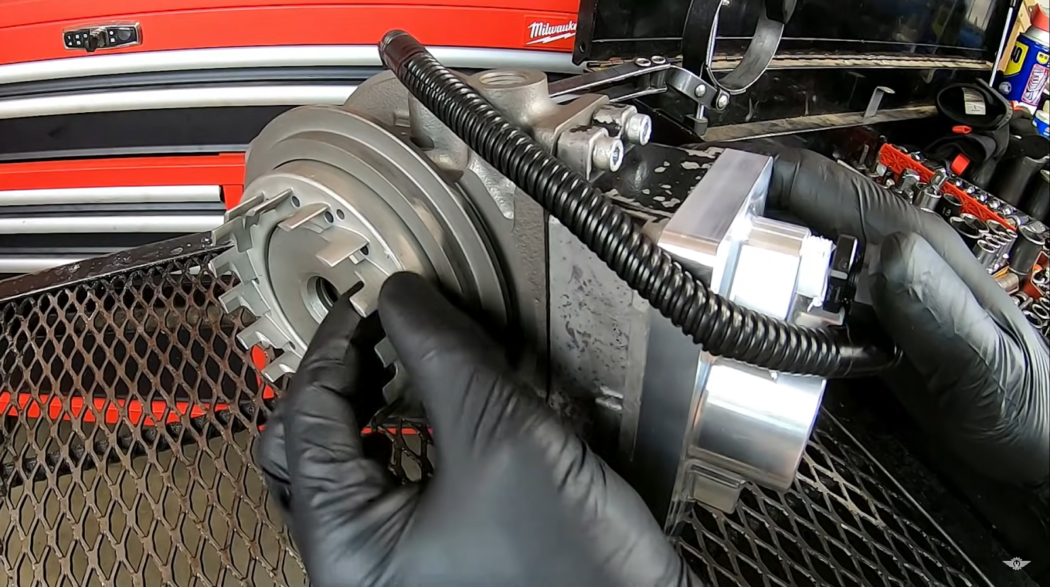If the diagnostic code P00AF appears on your Dodge Cummins engine, you might find yourself delving into your manual to understand the situation. Chances are high that this issue pertains to your engine and could necessitate a visit to your mechanic.
The presence of a P00AF code on any vehicle signals a problem with the turbo. In the case of a Dodge Cummins, this indicates that your powertrain control module has detected an issue with your turbocharger or turbo boost. Resolving this requires the replacement of the problematic turbo component.
In the following sections, I will provide you with fundamental information regarding the P00AF code’s impact on your powertrain control module. I will also outline specific symptoms in your Dodge vehicle that you should remain vigilant about. Furthermore, I will present several methods for effectively addressing this code.
P00AF Code on Dodge Cummins: Turbo Troubles Unveiled
If your Dodge Cummins displays a P00AF code, it’s a signal of an engine error that demands attention for your turbo or turbo boost. Typically, your boost control module communicates with your PCM when issues arise within this segment of your engine. Specifically, the P00AF code serves as an indicator of compromised performance.
The turbocharger, often referred to simply as the turbo, plays a pivotal role in enhancing acceleration and smoothness in your vehicle. While some cars come equipped with a turbo, others can be customized to include one, contributing to improved speed and acceleration and potentially even boosting fuel efficiency.
The P00AF code specifically appears in Cummins vehicles with VGT units, such as the 6.7L Dodge Cummins. This code generally points to a malfunctioning component within the turbo system.
These components may include:
- The turbo itself;
- One of the sensors;
- The actuator or nozzle;
- The associated wiring.
When the P00AF code emerges, you might notice a decline in performance. However, it’s important to address this issue promptly, even though there’s a chance it could be a PCM error.
It’s possible to continue driving with a damaged turbo, but doing so risks affecting other critical internal elements of your engine. Taking a short test drive can help determine if the code is erroneous. If it is, your vehicle might have a faulty PCM that necessitates replacement.
If the P00AF code isn’t an error, you might experience delayed acceleration, challenges when increasing speed on the highway, or even unusual engine noises during acceleration.
It’s essential to recognize that these symptoms don’t immediately indicate a completely failed turbo or a significant turbo-related issue. Instead, the solution might be simpler than anticipated.
Solution 1: Start with Warranty Assessment
To begin, delve into your warranty documentation. Are you the holder of a powertrain or a drivetrain warranty?
In the realm of vehicle warranties, a turbo commonly falls within the coverage of a powertrain warranty. This warranty encompasses components responsible for generating power and facilitating movement, encompassing elements such as tires, axles, the engine, and indeed, the turbo.
If your turbo issue falls within the scope of your warranty, the ensuing steps are likely to be straightforward. Your course of action involves visiting a mechanic who honors the warranty. Here, the essential processes involve meticulous inspection, replacement of necessary parts, and pertinent actions, all without the need for delving under the hood or conducting intricate diagnostics.
Solution 2: Consulting a Professional Mechanic
Turbo maintenance differs significantly from routine tasks like changing oil. While replacing oil might be manageable with a bit of guidance, dealing with turbos requires a much more intricate approach.
- Why the complexity? Turbos are integrated within your engine, demanding a discerning eye to pinpoint the precise underlying problem. Your local mechanic may begin by attempting to cleanse the turbo, assessing whether the error code vanishes before moving on to potential part replacements;
- If navigating the intricate workings under your vehicle’s hood isn’t within your realm of expertise, I recommend entrusting the task to a qualified mechanic. Opting for professional assistance from the outset is wiser than attempting to manipulate turbo components without the necessary knowledge, inadvertently giving rise to new complications;
- When you consult your mechanic, simply communicate the presence of the P00AF code and offer insights into any accompanying symptoms your vehicle has exhibited. Details like acceleration challenges, auditory anomalies, unusual odors, and the like can greatly aid their diagnostic process.

Solution 3: Turbo Replacement
Should you possess a comfort level with diesel engines and are unfazed by a little oil on your hands, resolving the P00AF code could involve replacing the turbo yourself.
The inherent fragility of the stock VGT turbo on a 6.7L Cummings is notable. With a considerable likelihood of impending failure, it’s pragmatic to preemptively replace it to save both time and money.
Attempting to repair a malfunctioning VGT turbo is not advisable. Such interventions often result in a temporary fix followed by a turbo failure within a few months, necessitating further laborious vehicle disassembly.
When considering replacement options, turn your attention to upgraded VGT turbos from reputable manufacturers like BD Diesel & Fleece. While they might carry a higher price tag compared to stock alternatives, their enhanced durability and efficiency make them worthwhile investments.
Alternatively, explore the possibility of transitioning from a VGT to a fixed-geometry turbo (FGT). Although VGT guarantees optimal performance across RPM ranges, its complexity compromises longevity due to numerous moving components. FGT units, while optimized at specific RPMs, boast simplicity and robustness.
A customized FGT provides added benefits, including reduced exhaust gas temperature, elevated peak boost, and lowered drive pressure. As a result, the strain on other engine components diminishes, culminating in overall improved performance.
However, transitioning to an FGT unit does come with drawbacks. Firstly, the removal of VGT leads to the loss of the exhaust brake feature. Engine brake efficacy often deteriorates prior to VGT failure, showcasing the exhaust system backpressure’s impact on vehicle speed, braking distance, and brake system longevity.
Secondly, selecting an FGT unit ill-suited for the 6.7L Cummins engine is plausible given the abundance of options. As the 6.7L Cummins wasn’t originally designed for FGT, careful consideration is vital to prevent pairing with an incompatible unit. For FGT conversions, it’s prudent to entrust the task to proficient mechanics who are equipped to handle the intricacies involved.
Solution 4: Actuator Replacement: Unveiling the Culprit
In instances where the turbo is faultless, the next potential suspect to scrutinize is the actuator. The actuator, or boost control module, holds the responsibility of adjusting the turning vanes within the VGT to align with the engine’s power requirements.
While the option to substitute the actuator with another stock counterpart exists, I strongly recommend steering clear. The rationale? Durability takes center stage. Cummins, in response to consumer feedback, has augmented the longevity of their turbo components. However, aftermarket alternatives offer not only enhanced performance but also superior resilience. Additionally, the stock VGT actuator tends to come with a heftier price tag compared to its aftermarket counterparts. Moreover, the post-installation necessity of programming a stock actuator for precise functionality mandates a visit to a Dodge auto shop for recalibration, incurring further expenses.
A majority of custom VGT actuators sidestep the recalibration requirement post-installation. These alternatives are not only more budget-friendly but also outshine the stock choice in terms of durability.
When procuring an aftermarket VGT actuator, ensure accurate specification of your vehicle’s year of manufacture. For 6.7L Cummins engines spanning from 2007.5 to 2012, a partial actuator replacement involving the circuit board section suffices. However, models from 2013 to 2018 necessitate complete actuator replacement.
The actuator replacement process encompasses these uncomplicated steps:
- Drain the coolant;
- Unfasten the bolts securing the actuator;
- Verify free gear movement;
- Remove and replace the actuator (employ half-actuator, if applicable);
- Install the new unit;
- Replenish the coolant.
Solution 5: Inspect the Vehicle’s Electrical System

When examining the turbocharger’s functionality, it’s important to consider both its mechanical components and the intricate electrical system that supports it. While the turbo’s mechanical parts might seem to be functioning properly, it’s worth noting that issues can sometimes originate from the electrical aspects of the system. This realization underscores the need for a comprehensive inspection of not only the turbo’s mechanical components but also the wiring and sensors intricately integrated within the turbocharger setup.
In instances where doubts or concerns arise about the condition of the wiring or sensors, taking a proactive stance involves opting for their outright replacement. This strategic move holds significant importance, not just for ensuring the optimal operation of the turbocharger, but also for ensuring the overall reliability and health of these indispensable components.
However, should the persistence of the P00AF code continue despite these proactive steps, the root cause might potentially be traced back to a malfunctioning PCM (Powertrain Control Module). The PCM, which plays a pivotal role in regulating the vehicle’s various systems, can sometimes produce misleading fault codes, adding a layer of complexity to the diagnostic process. In such scenarios, when previously attempted solutions prove ineffective, seeking the expertise of a certified professional becomes a wise course of action. These professionals possess the knowledge and tools necessary to thoroughly assess the condition of the PCM.
In more challenging cases, where the issue remains unresolved, the consideration of replacing the PCM with a new unit becomes a potential solution. This strategic approach aims to definitively address the problem at its source, potentially eliminating the persistent issue once and for all.
Conclusion
Encountering the P00AF code emblazoned on your PCM ushers in a pivotal juncture for conscientious observation in your Dodge Cummins journey. This code unfurls as an eloquent messenger, directing your focus toward the acceleration realm. Its appearance serves as an unequivocal indication, prompting you to embark on a journey of exploration encompassing turbo maintenance that spans from scrutiny to possible replacement, and even the integration of novel components.
It’s crucial to comprehend that the P00AF code doesn’t cast a shadow of impending catastrophe. The absence of a towing imperative offers solace, ensuring that it’s not an acute crisis that mandates immediate cessation of operation. However, the code’s presence should not be misconstrued as benign negligence. While your vehicle remains operational, time should not lull you into complacency.











